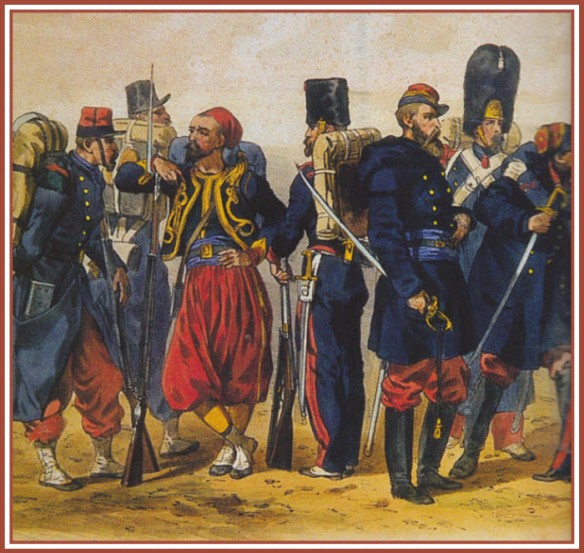In return for French commitments to cancel their support for the Black Sea clauses of the Paris Treaty, Alexander promised only armed neutrality, mobilizing a large Russian force on the border with Galicia to prevent the Austrians from sending troops to Italy. The Austrians had used armed neutrality in favour of the allies during the Crimean War, and Alexander’s decision to follow the same tactic let him take revenge on Austria for its betrayal. Napoleon, for his part, was unwilling to give a firm pledge on the Black Sea clauses, fearing it would damage his relations with Britain, so no formal treaty with the Russians could be reached. But there was a gentlemen’s agreement between the emperors, signed in March 1859, by which the Russians would adopt a stance of ‘benevolent neutrality’ in the event of a Franco-Austrian war in exchange for French ‘good offices’ at a ‘future date’.
It was on this basis that the French and Piedmontese began their war against Austria in April 1859, in the knowledge that the Russians would advance 300,000 troops towards the Austrian frontier while they attacked in Italy. Only a few years before, Russia would have given military support to Austria against any French attempts to revise the Vienna treaty. The Crimean War had changed everything.
Under the command of Napoleon III and Victor Emmanuel, the Franco-Piedmontese army won a series of rapid victories, destroying the Austrian forces under the command of Emperor Franz Joseph at the battle of Solferino on 24 June, the last major battle in history in which all the armies were under the personal command of their monarchs. By this time, Napoleon was afraid that the German states might take up arms in support of Austria; therefore, without telling the Piedmontese, he signed an armistice with the Austrians at Villafranca, by which most of Lombardy, including its capital, Milan, was transferred to the French, who immediately gave it to Piedmont, as agreed by Napoleon and Cavour at Plombières. The Villafranca deal restored the monarchs of the central Italian states (Parma, Modena and Tuscany) who had been unseated by the popular revolts that broke out at the beginning of the war – a deal that enraged the Piedmontese, though it pleased the Russians, who had deep concerns about the way the Italian movement was taking a revolutionary turn. The Piedmontese army proceeded to annex the central states. Savoy and Nice were transferred to France, its agreed reward for helping the Italian cause.
In France, the names of the Crimea are found everywhere, reminders of a war in which 310,000 Frenchmen were involved. One in three did not return home. Paris has an Alma Bridge, built in 1856 and rebuilt in the 1970s, which is now mainly famous for the scene of Princess Diana’s fatal car crash in 1997. Until then it was better known for its Zouave statue (the only one of four to be kept from the old bridge) by which water levels are still measured by Parisians (the river is declared unnavigable when the water passes the Zouave’s knees). Paris has a place de l’Alma, and a boulevard de Sébastopol, both with metro stations by those names. There is a whole suburb in the south of Paris, originally built as a separate town, with the name of Malakoff (Malakhov). Initially called ‘New California’, Malakoff was developed in the decade after the Crimean War on cheap quarry land in the Vanves valley by Alexandre Chauvelot, the most successful of the property developers in nineteenth-century France. Chauvelot cashed in on the brief French craze for commemorating the Crimean victory by building pleasure-gardens in the new suburb to increase its appeal to artisans and workers from the overcrowded centre of Paris. The main attraction of the gardens was the Malakoff Tower, a castle built in the image of the Russian bastion, set in a theme-park of ditches, hills, redoubts and grottoes, along with a bandstand and an outside theatre, where huge crowds gathered to watch the reenactments of Crimean battles or take in other entertainments in the summer months. It was with the imprimatur of Napoleon that New California was renamed Malakoff, in honour of his regime’s first great military victory, in 1858. Developed as private building plots, the suburb grew rapidly during the 1860s. But after the defeat of France by Prussia in 1870, the Malakoff Tower was destroyed on the orders of the Mayor of Vanves, who thought it was a cruel reminder of a more glorious past.
Malakoff towers were built in towns and villages throughout provincial France. Many of them survive to this day. There are Malakoff towers in Sivry-Courtry (Seine-et-Marne), Toury-Lurcy (Nièvre), Sermizelles (Yonne), Nantes and Saint-Arnaud-Montrond (Cher), as well as in Belgium (at Dison and Hasard-Cheratte near Liège), Luxembourg and Germany (Cologne, Bochum and Hanover), Algeria (Oran and Algiers) and Recife in Brazil, a city colonized by the French after the Crimean War. In France itself, nearly every town has its rue Malakoff. The French have given the name of Malakoff to public squares and parks, hotels, restaurants, cheeses, champagnes, roses and chansons.
But despite these allusions, the war left much less of a trace on the French national consciousness than it did on the British. The memory of the Crimean War in France was soon overshadowed by the war in Italy against the Austrians (1859), the French expedition to Mexico (1862–6) and, above all, the defeat in the Franco-Prussian War. Today the Crimean War is little known in France. It is a ‘forgotten war’.
